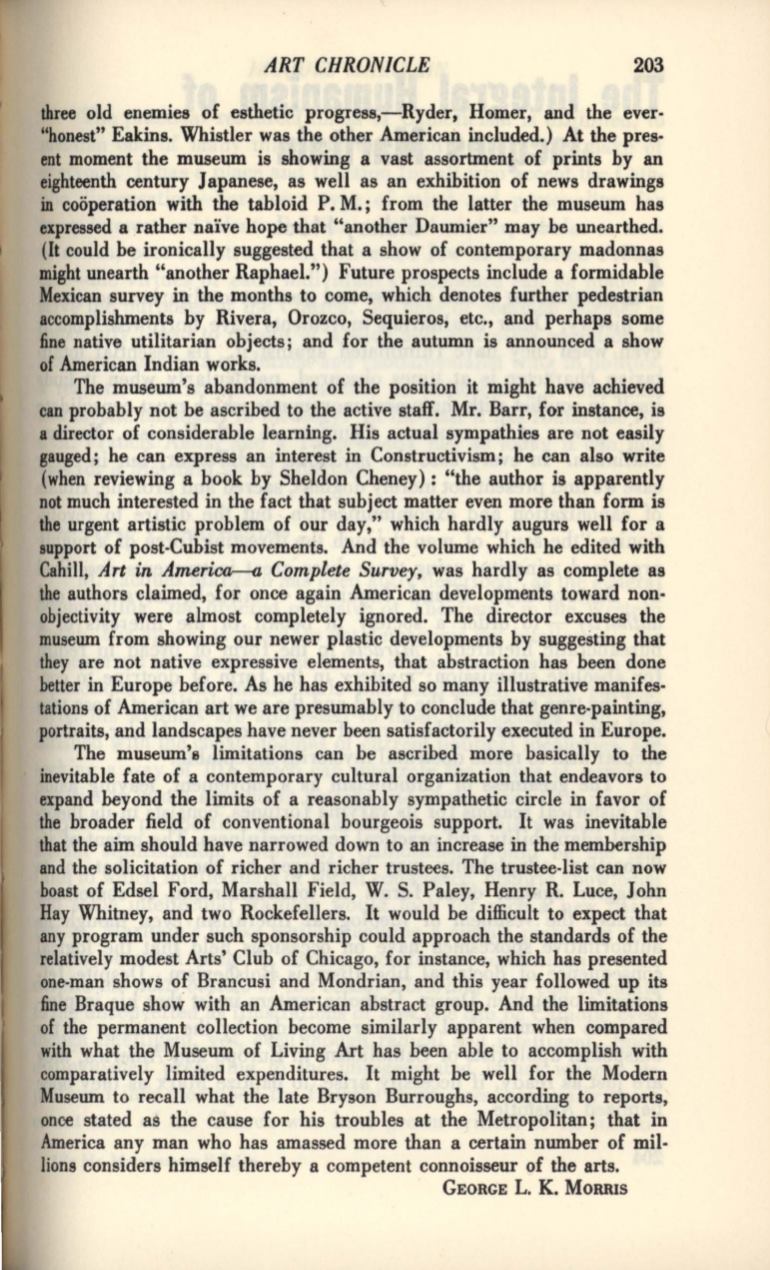
ART CHRONICLE
203
three old enemies of esthetic progress,-Ryder, Homer, and the ever–
"honest" Eakins. Whistler was the other American included.) At the pres–
ent moment the museum is showing a vast assortment of prints by an
eighteenth century Japanese, as well as an exhibition of news drawings
in cooperation with the tabloid P. M.; from the latter the museum has
expressed a rather naive hope that "another Daumier" may be unearthed.
(It could be ironically suggested that a show of contemporary madonnas
might unearth "another Raphael.") Future prospects include a formidable
Mexican survey in the months to come, which denotes further pedestrian
accomplishments by Rivera, Orozco, Sequieros, etc., and perhaps some
fine native utilitarian objects; and for the autumn is announced a show
of American Indian works.
The museum's abandonment of the position it might have achieved
can probably not be ascribed to the active staff. Mr. Barr, for instance, is
a director of considerable learning. His actual sympathies are not easily
gauged; he can express an interest in Constructivism; he can also write
(when reviewing a book by Sheldon Cheney): "the author is apparently
not much interested in the fact that subject matter even more than form is
the urgent artistic problem of our day," which hardly augurs well for a
support of post-Cubist movements. And the volume which he edited with
Cahill,
Art
in
Amenca-a
Complete
Survey,
was hardly as complete as
the authors claimed, for once again American developments toward non–
objectivity were almost completely ignored. The director excuses the
museum from showing our newer plastic developments by suggesting that
they are not native expressive elements, that abstraction has been done
better in Europe before. As he has exhibited so many illustrative manifes–
tations of American art we are presumably to conclude that genre-painting,
portraits, and landscapes have never been satisfactorily executed in Europe.
The museum's limitations can be ascribed more basically to the
inevitable fate of a contemporary cultural organization that endeavors to
expand beyond the limits of a reasonably sympathetic circle in favor of
the broader field of conventional bourgeois support.
It
was inevitable
that the aim should have narrowed down to an increase in the membership
and the solicitation of richer and richer trustees. The trustee-list can now
boast of Edsel Ford, Marshall Field, W. S. Paley, Henry
R.
Luce, John
Hay Whitney, and two Rockefellers. It would be difficult to expect that
any program under such sponsorship could approach the standards of the
relatively modest Arts' Club of Chicago, for instance, which has presented
one-man shows of Brancusi and Mondrian, and this year followed up its
fine Braque show with an American abstract group. And the limitations
of the permanent collection become similarly apparent when compared
with what the Museum of Living
Art
has been able to accomplish with
comparatively limited expenditures. It might be well for the Modern
Museum to recall what the late Bryson Burroughs, according to reports,
onc-e stated as the cause for his troubles at the Metropolitan; that in
America any man who has amassed more than a certain number of mil–
lions considers himself thereby a competent connoisseur of the arts.
GEORGE
L. K.
MORRIS


